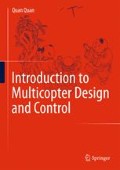Abstract
The state of a multicopter may not be measured directly by existing sensors. For example, since the speed of a multicopter is very low, its accurate value is difficult to be measured directly.
Access this chapter
Tax calculation will be finalised at checkout
Purchases are for personal use only
References
Chen CT (1999) Linear system theory and design, 3rd edn. Oxford University Press, New York
Banerjee S, Roy A (2014) Linear algebra and matrix analysis for statistics. CRC Press, London
Vidyasagar M (2002) Nonlinear systems analysis. Society for Industrial and Applied Mathematics, Philadelphia
Hermann R, Krener AJ (1977) Nonlinear controllability and observability. IEEE Trans Autom Control 22(5):728–740
Leishman RC, Macdonald JC, Beard RW, McLain TW (2014) Quadrotors and accelerometers: state estimation with an improved dynamic model. IEEE Control Syst Mag 34(1):28–41
Kalman RE (1960) A new approach to linear filtering and prediction problems. J Basic Eng-T ASME 82(1):35–45
Gelb A. (Ed.) (1974) Applied optimal estimation. MIT Press, Cambridge, MA
Crassidis JL, Junkins JL (2011) Optimal estimation of dynamic systems. CRC Press, Boca Raton
Cristi R, Tummala M (2000) Multirate, multiresolution, recursive Kalman filter. Signal Process 80(9):1945–1958
Sun SL, Deng ZL (2004) Multi-sensor optimal information fusion Kalman filter. Automatica 40(6):1017–1023
Simon D (2006) Optimal state estimation: Kalman, H infinity, and nonlinear approaches. Wiley, New Jersey
Soatto S, Frezza R, Perona P (1996) Motion estimation via dynamic vision. IEEE Trans Autom Control 41(3):393–413
Müller PC, Weber HI (1972) Analysis and optimization of certain qualities of controllability and observability for linear dynamical systems. Automatica 8(3):237–246
Author information
Authors and Affiliations
Corresponding author
Rights and permissions
Copyright information
© 2017 Springer Nature Singapore Pte Ltd.
About this chapter
Cite this chapter
Quan, Q. (2017). Observability and Kalman Filter. In: Introduction to Multicopter Design and Control. Springer, Singapore. https://doi.org/10.1007/978-981-10-3382-7_8
Download citation
DOI: https://doi.org/10.1007/978-981-10-3382-7_8
Published:
Publisher Name: Springer, Singapore
Print ISBN: 978-981-10-3381-0
Online ISBN: 978-981-10-3382-7
eBook Packages: EngineeringEngineering (R0)

